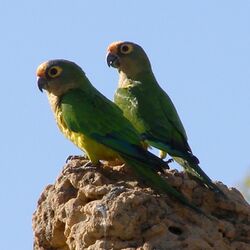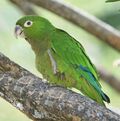Biology:Eupsittula
From HandWiki
Short description: Genus of birds
| Eupsittula | |
|---|---|

| |
| Peach-fronted parakeet (Eupsittula aurea) on a termite mound in Brazil | |
| Scientific classification | |
| Domain: | Eukaryota |
| Kingdom: | Animalia |
| Phylum: | Chordata |
| Class: | Aves |
| Order: | Psittaciformes |
| Family: | Psittacidae |
| Subfamily: | Arinae |
| Genus: | Eupsittula Bonaparte, 1853 |
| Type species | |
| Psittacus petzii[1] = Psittacus canicularis Leiblin, 1832
| |
| Species | |
|
Eupsittula nana | |
Eupsittula is a genus of South and Middle American parakeets in the tribe Arini. Until 2013, all the species were believed to belong to the genus Aratinga.[2] Some of the Eupsittula species are kept in aviculture or as companion parrots, where they are commonly known as conures.
Taxonomy
The genus Eupsittula was introduced in 1853 by the French naturalist Charles Lucien Bonaparte with the orange-fronted parakeet as the type species.[3][4] The genus name combines the Ancient Greek eu meaning "good" with the Modern Latin psittula meaning "little parrot".[5]
The genus contains five species.[6]
| Image | Scientific name | Common Name | Distribution |
|---|---|---|---|
 |
Eupsittula aurea (Gmelin, 1788) | peach-fronted parakeet | eastern Brazil, Bolivia, Paraguay, far northern Argentina and southern Suriname (Sipaliwini savanna). |
 |
Eupsittula cactorum (Kuhl, 1820) | Caatinga parakeet, or cactus parakeet | Caatinga region in north-eastern Brazil. |
 |
Eupsittula canicularis (Linnaeus, 1758) | orange-fronted parakeet, or half-moon conure | western Mexico to Costa Rica. |
 |
Eupsittula nana (Vigors, 1830) | olive-throated parakeet | Jamaica, Mexico, and Central America; introduced to the Dominican Republic |
 |
Eupsittula pertinax (Linnaeus, 1758) | brown-throated parakeet, or St. Thomas conure | Colombia, Venezuela, the Guianas, Trinidad and Tobago, the ABC islands in the Netherlands Antilles, and northern Brazil (mainly the Rio Negro/Branco region) |
References
- ↑ "Psittacidae". The Trust for Avian Systematics. https://www.aviansystematics.org/4th-edition-checklist?viewfamilies=67.
- ↑ Remsen, J.V., Jr.; Schirtzinger, E.E.; Ferraroni, A.; Silveira, L.F.; Wright, T.F. (2013). "DNA-sequence data require revision of the parrot genus Aratinga (Aves: Psittacidae)". Zootaxa 3641 (3): 296–300. doi:10.11646/zootaxa.3641.3.9. PMID 26287088.
- ↑ Bonaparte, Charles Lucien (1853). "Notes sur les collections rapportées en 1853, par M. A. Delattre" (in French). Comptes Rendus Hebdomadaires des Séances de l'Académie des Sciences 37: 806–810 [807]. https://www.biodiversitylibrary.org/page/1216907.
- ↑ The Howard & Moore Complete Checklist of the Birds of the World. 1: Non-passerines (4th ed.). Eastbourne, UK: Aves Press. 2013. p. 366. ISBN 978-0-9568611-0-8.
- ↑ Jobling, James A. (2010). The Helm Dictionary of Scientific Bird Names. London: Christopher Helm. p. 153. ISBN 978-1-4081-2501-4. https://archive.org/stream/Helm_Dictionary_of_Scientific_Bird_Names_by_James_A._Jobling#page/n153/mode/1up.
- ↑ Gill, Frank; Donsker, David; Rasmussen, Pamela, eds (January 2022). "Parrots, cockatoos". IOC World Bird List Version 12.1. International Ornithologists' Union. https://www.worldbirdnames.org/bow/parrots/. Retrieved 16 March 2022.
Wikidata ☰ Q14472604 entry
 |

